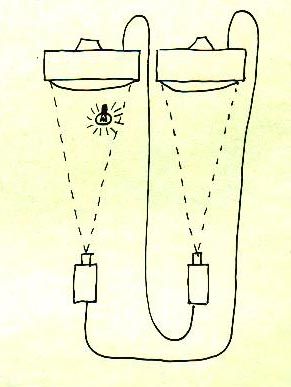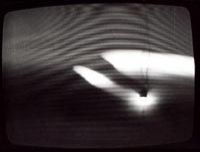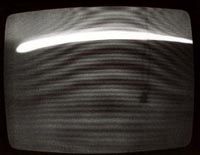|
|

INPUT - OUTPUT (2)
The latter part of the last sentence in the description of the previous installation is a great
simplification, one should not overestimate the power of imagination. 'Something' is going on with the
time, whereas 'nothing' is going on with the picture itself. It seems to one's imagination that 'I', as the very object of the current transmission and 'I' in the umpteenth one is the same person, although a little bit
distorted. But then, how far can we go with this distortion in our further encoding and decoding of the picture and still preserve such
identification?
It is an attempt to carry out the theoretical postulate which concludes the description of the
previous
installation.
In it, the transmission would develop from 1 to 2, from 2 to 3, from 3 to... Whereas in this particular one, the transmission oscillates between 1 and 2, 2 and 1, 1 and 2, etc.
Camera 1 transmits the picture of a burning bulb to monitor 2.
Camera 2 transmits the picture from monitor 2 to monitor 1.
If the real bulb is no longer burning, the initited chain of transmission
continues. It resembles a ping-pong game, yet here in this case the ball/bulb gets slightly distoterd by each and every stroke of the bat.
The apparent speed at which the picture circulates within the system makes it impossible for us to have a close look at every single
transmission.
| |





We can,
however, in a short period of time, see (and not imagine) our burning bulb within the range of an umpteenth
transmission. The picture circulates in the system at a speed of 12 cycles per
second. So after one minute, our 'umpteenth' transmission becomes transmission number 720.
Thus, we can modify the latter part of the concluding sentence in the description of the
previous installation in the following
way: if at the
input of
transmission 1 I, as its very object, wave my hand, at the output of transmission 720 I will do it in one
minute, provided it still is really me.
According to the theory behind structural cinema, 'I' in this case is nothing but a special configuration of silver grains in a film
frame.
Multitransmission comes to its end once the object of transmission misses the optical axis of the system. It can be prevented by continuously adjusting the optical axis of one of the cameras. In such a way and with some practice, the transmission can be sustained indefinitely.
At first, I claimed that this installation generates fictitious time. The answer is both Yes and No. No, if what we mean are pure abstractions. Are we able to see them ? Yes, if what we mean is intervalic actualization of the past, an optically-electronic combination of what was and what is,
violation of the concept of continuum.
|


